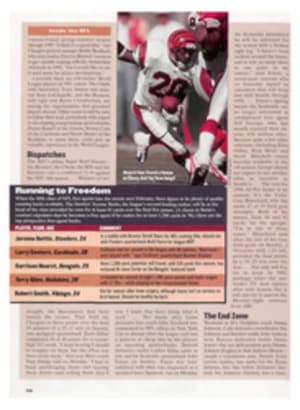
THE WORLD'S LARGEST ICE RINK ONE CAN SKATE FOR ALMOST FIVE MILES ON THE RIDEAU CANAL IN CANADA'S CAPITAL
Imagine 125 Olympic-sized rinks strung end-to-end, a ribbon of
ice winding through a scenic little city. Canadians have such a
thing: It's a national treasure called the Rideau Canal
Skateway, which cuts through the heart of Ottawa, the nation's
capital. You can skate for 7.8 kilometers--nearly five miles--on
the canal without breaking stride. On winter weekday mornings
you might see briefcase-toting commuters skating to work, or
groups of college students skating to class. Later come moms
chatting as they skate side by side, pushing bundled-up babies
in strollers. And "on the weekend it's almost like a boardwalk,"
says Ottawa resident Jaap Schouten, who often skates to and from
his downtown office. "You meet your friends there."
Though the canal dates back to 1826--it was built as an inland
link between Ottawa and Kingston--skating on it began only 27
years ago. The proposal to clear the canal for skating was made
by former National Capital Commission chairman Douglas
Fullerton, but it drew criticism from engineers who feared
damage to the concrete walls of the waterway, which is used for
pleasure boating in the summer. Fullerton persevered, and in
1969 the Skateway opened. It now stretches from the shadows of
Parliament Hill to the Hartwell Locks at Carleton University.
Maintenance of the Skateway, which costs the commission about
$375,000 (U.S.) a year, requires up to 50 full-time employees
and a fleet of snowblowers, plows, tractor-mounted augers and
other equipment--but not a single Zamboni. Green flags above the
canal signify the best skating conditions; yellow flags, fair to
good conditions; red flags, unsafe conditions and closed for
skating.
The 1993-94 season had the most consecutive green-flag days in
the Skateway's history (41) between opening day and the start of
Winterlude, an annual celebration over three consecutive
February weekends that features snow and ice sculptures, barrel
jumping, figure skating demonstrations and winter triathlons.
Most years the canal opens between Christmas and New Year's Day,
and the skating often continues well into March. As many as
750,000 skaters use the canal in a season. But no two years are
the same.
"Every year you learn something," says Steve Estabrooks, chief
of canal operations since 1980. "The ideal start is when you get
cold, cold weather early. In a couple of days you can grow
seven, eight inches of clear ice that you can see right through.
It's just like a bottle. Then if you get some snow on it, the
first piece of equipment down is a pickup truck with a plow."
Snow is a most unwelcome insulator. It not only hampers the ice
from growing downward but also turns the skating surface into
mush. To keep the surface smooth, workers flood the canal almost
nightly. First, sweeper trucks spinning six-foot nylon-and-steel
brushes push the skate shavings to the snowy shoulder. Then the
flooding crews plunge intake hoses through holes that have been
cut in the ice--each perforation the size of a salad plate--and
pump out a smoothing layer of water that freezes in minutes. End
to end, the job takes eight hours.
Along the canal there are warm chalets, in which people can
change into their skates before setting off. There are also
skate-sharpening and skate-rental trailers, heated rest rooms,
and food stands serving hot chocolate, cider and beavertails.
This last item, an aptly named puff pastry, is served hot and
sweet, most often topped with cinnamon sugar and a squeeze of
lemon: perfect fuel for the return leg of an end-to-end canal
skate.
Freelancer John Grossmann, of Jamison, Pa., is a frequent
contributor to Sports Illustrated.
COLOR PHOTO: PETER SIBBALD On winter weekends Ottawans converge on the Skateway for recreation and companionship. [Ice skaters on Rideau Canal Skateway]

